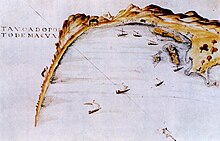| Battle of Massawa (1541) | |||||||
|---|---|---|---|---|---|---|---|
 Drawing of Massawa by D. João Castro c. 1541 | |||||||
| |||||||
| Belligerents | |||||||
|
|
| ||||||
| Commanders and leaders | |||||||
|
|
| ||||||
| Strength | |||||||
| 100 men | Unknown | ||||||
| Casualties and losses | |||||||
| All but 2 killed | Unknown | ||||||
| Ethiopian–Adal War | |
|---|---|
The Battle of Massawa was an armed encounter between the Portuguese Empire and the Adal Sultanate near Massawa in 1541. The Adalites destroyed the Portuguese force.
After their defeat at the Battle of Suez, the Portuguese navy returned, spending another month at Massawa in May. At Massawa The Portuguese force rejoined with their comrades, suffering losses under the scorching sun, due to the bad climate in the port and the lack of provisions that took a heavy toll on the Portuguese which led to a mutiny of a hundred soldiers, threatening to kill their commander, Manuel da Gama, when he tried to resist them, the mutineers then set forth into the barren hinterlands, they were led by Fidalgo Antonio Correa during their march, they made a martial show, with a flag flying and a band of music to keep them going. However, their march followed a with hot night, soon they were suffering of thrist until they were suddenly attacked by the troops of Ahmad ibn Ibrahim al-Ghazi, the Adalites swooped down on them and killed them, including their commander Antonio. Only two managed to survive this massacre and return to their ships alive.
References
- Giancarlo Casale, The Ottoman Age of Exploration, p. 70
- K.G. Jayne, Vasco Da Gama and His Successors, 1460–1580
- John Jeremy Hespeler-Boultbee, A Story in Stones Portugal's Influence on Culture and Architecture in the Highlands of Ethiopia 1493-1634, p. 180
- Andreu Martínez d'Alòs-Moner, Envoys of a Human God, The Jesuit Mission to Christian Ethiopia, 1557-1632, p. 34
Categories: